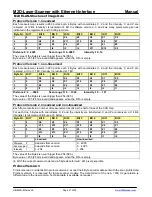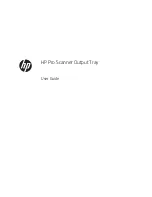
M2D-Laser-Scanner with Ethernet-Interface
Manual
HB-M2D-Ethernet-E
Page 7 of 39
www.MElsensor.com
simultaneous Sync
alternating Sync simultaneous Trigger
alternating Trigger
E
E
x
x
t
t
e
e
r
r
n
n
a
a
l
l
-
-
T
T
r
r
i
i
g
g
g
g
e
e
r
r
/
/
H
H
a
a
r
r
d
d
w
w
a
a
r
r
e
e
-
-
T
T
r
r
i
i
g
g
g
g
e
e
r
r
Pin 15 = Sync-input is triggered with a 0/1 slope = low-high-transit. The trigger signal should be free from
hazardous oscillations. Pin 15 is an optical coupled input with current limit. The input accepts voltage from TTL …
24V, max. 30 V DC.
When a triggered measurement is made, no other trigger signal is considered from the sync input, while the
image is “read”. The maximum scan rate in trigger mode is approx. 75 Hz. Trigger mode must be preset with
register 0x14 (20) = “1”, single shot with trigger. In trigger mode, synchronization is not possible.
S
S
y
y
n
n
c
c
h
h
r
r
o
o
n
n
i
i
z
z
a
a
t
t
i
i
o
o
n
n
Synchronization uses the Sync-input pin 15. One scanner is dedicated to be “Master” while all others are “Slaves”.
Pin 2 of the “Master” is connected to Pin 15 of the Slaves, ground pins are connected accordingly. The Master
sends a sync out signal on pin 2. The slaves receive the sync signal on pin 15. Ground pins = 1, 14. After
receiving the sync pulse, the Slave-Scanner modifies his timing accordingly. For measurement on request, use
Ethernet-Trigger mode (see below!). The sync input can be left open without special wiring.
E
E
t
t
h
h
e
e
r
r
n
n
e
e
t
t
-
-
T
T
r
r
i
i
g
g
g
g
e
e
r
r
M
M
o
o
d
d
e
e
Ethernet-Trigger Mode is set with Register 0x23 according to definition on page …. In this mode, the sensor
acquires profile data continuous, but sends out data over Ethernet only on request. The internal FiFO is not in
use. The actual profile at time of trigger event is sent out. Depending on the speed of the PC, images could be
missing.
D
D
i
i
g
g
i
i
t
t
a
a
l
l
i
i
n
n
p
p
u
u
t
t
s
s
From PC board version 1.3 on, the digital inputs may be used to feed encoder signals. The digital A/B-inputs feed
a counter, which is read out over the registers 13…16. The encoder counter information is sent with every
complete profile data package. This makes sure, that the position of each profile is always in sync with the motion
position of the scanner.
R
R
e
e
a
a
d
d
o
o
u
u
t
t
c
c
o
o
m
m
p
p
l
l
e
e
t
t
e
e
i
i
m
m
a
a
g
g
e
e
The complete camera image is read out. No recognition of the scan data is made, that means, the sensor sends
out raw data with 8 bit resolution. When the register 0x10 is set to “1”, the sensor writes 2 fields complete into the
FiFo. After each field, 8 Byte zero’s and 4 status Bytes are transferred. The read out of a new image starts with a
hardware or software trigger event.
We recommend to empty the FiFO before reading Scanner data. The FiFo is 512 kByte.
Intensity of the pixels values are 0 … 254.
S
S
y
y
n
n
c
c
h
h
r
r
o
o
n
n
i
i
z
z
e
e
S
S
e
e
n
n
s
s
o
o
r
r
s
s
„Synchronizing“ means the simultaneous or alternating read out of the sensors. For synchronization, the Pins
Sync out of the Master-Scanner and sync in of the Slave-Scanner unit must be connected, as well as ground pins.
Pin 2 of the master sensor is connected to pin 15 of the slave sensor. Both image counters work now
synchronous. Phase error is less than 10 µsec. When register 0x0F is set to „1“, both sensors measure
alternating. Shutter time in register „2“ and „3“ must be limited to the value 130, in order to avoid overlap of the
two sensors.
T
T
r
r
i
i
g
g
g
g
e
e
r
r
M
M
o
o
d
d
e
e
Trigger mode must be activated in the register 0x14, Bit 3 with a “1”. Hardware trigger is made with a leading
edge of the sync input, pin 15. Software trigger is made by accessing the register 0x1D. Software trigger and
hardware trigger both have the same function. In both modes, the sensor reacts on the leading (rising) 0/1-edge
of the trigger impulse. The capture process starts 65 µsec after trigger. The image counter is reset, two fields are
sent out.








































